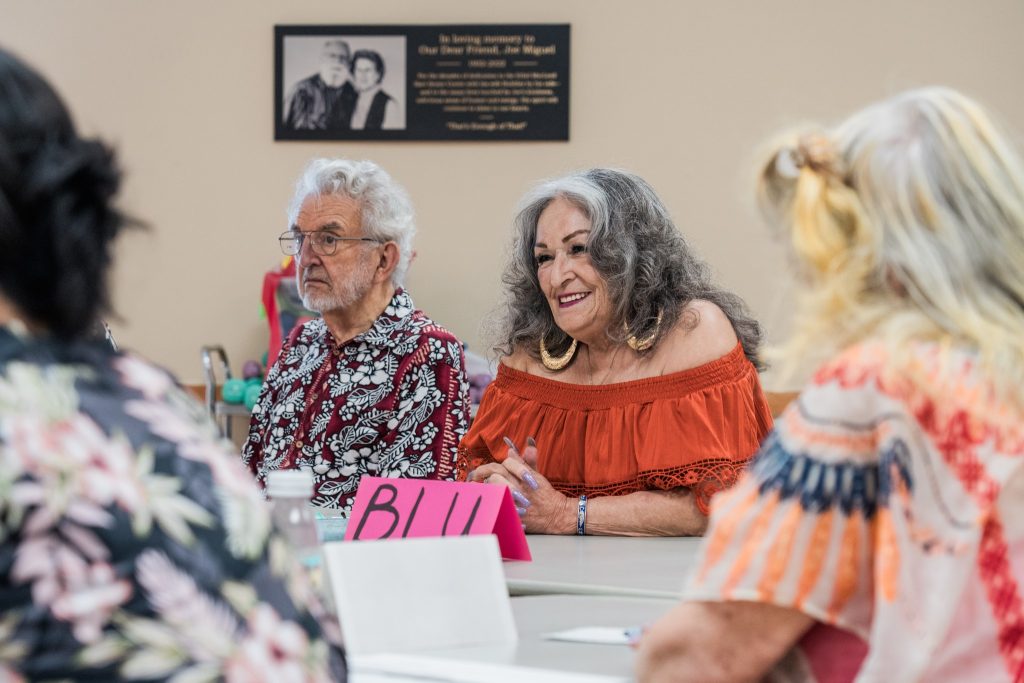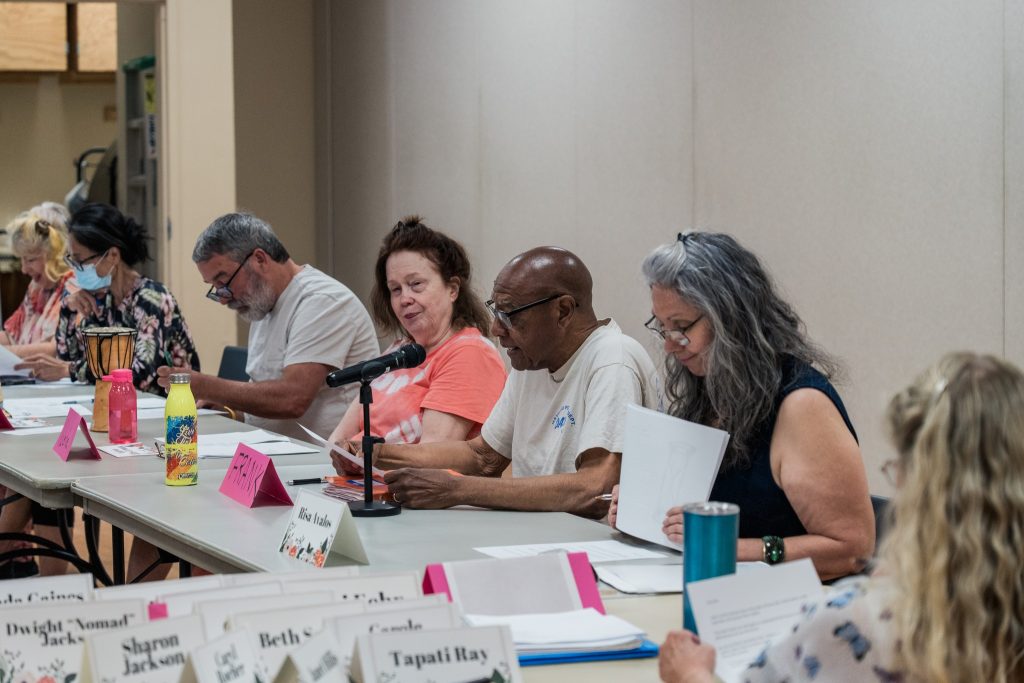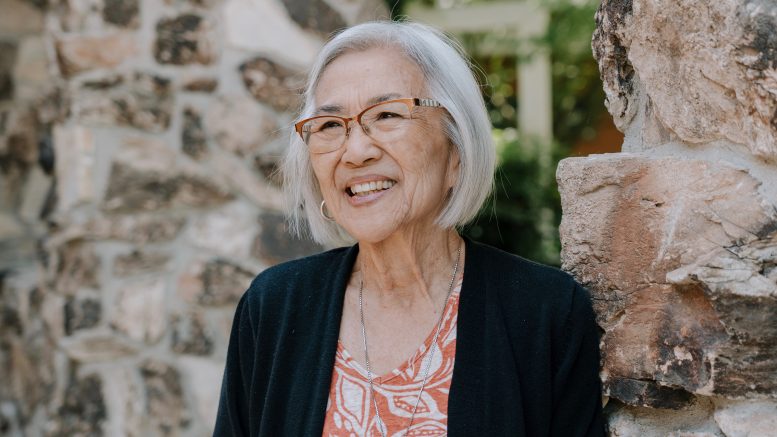By Helen Harlan
It’s 2 p.m. on a Tuesday at Ethel MacLeod Hart Senior Center in Marshall Park in Midtown Sacramento. Inside a room they call Redwood West, almost two dozen seniors sit in a roundtable where they will remain for the next hour and a half. Jessica Wimbley, a local artist, sits with them. She is the youngest person here by decades and is present to guide, engage and participate in the class.
This is the Hart Center’s weekly “Poetry Writing Group,” one of many free arts classes they offer to the public. The center is run by the City of Sacramento and, like all the programming the center has to offer, the group aims to provide a place to socialize and build community for people over 50.
Wimbley joined the poetry group in February as part of her community outreach work with the Capital Region Creative Corps Program. She is one of five artists in the Creative Corps selected to serve for up to one year in various city departments, like The Hart Center.
Olga Blu Gene Brown, who everyone calls “Blu,” 76, facilitates the group and has been coming for 14 years. She says the group has helped with her mental health struggles. “It’s a major, major plus,” she says. “My husband recently passed away. The last year and a half have been really hard for me. But by writing, and expressing myself through poetry, it’s helped me a lot with my anxiety and depression.”
Arlene Nakamura, 76, says she often uses the group to write about humor in senior issues. “There are a lot of sentiments that come with aging,” Nakamura says with a smile. “I kind of focus on the silly, funny stuff.”
Groups like the one Brown and Nakamura are part of illustrate the correlation of a quickly growing topic: arts and public health. While the center, its programming and those who carry it out are not considered prescribed treatment for any health condition, anecdotal evidence like what Brown and Nakamura share point to an undeniable link between the two, suggesting that access to the arts can promote well-being.
Holistic approach to health

A University of Florida College of the Arts Center for Arts in Medicine study published earlier this year found evidence to support this link. The study, “Arts & Culture in Public Health, An Evidence-Based Framework,” is accepted by some experts in the arts and public health conversation as a valuable go-to for where the two intersect and how that intersection can boost a community’s overall health.
According to the framework, by offering arts and enrichment classes in a public space, the Hart Center should indeed be seeing positive results in participants in areas of health. Mechanisms outlined in the framework like “Expression & Being Heard,” result in the creation of a safe, inclusive and engaging space, potentially producing three positive, evidence-based outcomes.
Janeen Thorpe, the Hart Center’s director, says they are not actively tracking data on the mental and physical benefits members see from their classes. “But that’s a really good idea,” Thorpe says. “I think I do that on a very informal level. I want to know that the folks are benefitting.”
The Hart Center, founded in 1961, is a small, local example of the bigger, national conversation around arts and public health. And it’s a conversation of great value to many in Sacramento’s art and public works community.
Melissa Cirone, the City of Sacramento’s Office of Arts and Culture program manager, is a big fan of the topic and the UF framework.
“Personally, I think we’ve entered a sort of perfect storm where the research is starting to catch up with the work that’s already being done in the field,” Cirone says. “It’s probably been happening for as long as the arts have been happening in the world. But now, we’re starting to put the pieces together. I’m sure there are practitioners out there who are looking for alternatives for patients who have pain due to neurological issues, who are suffering from depression, and there’s not been a lot for them to offer through traditional medicine.”
Wimbley is familiar with the connection between the two sectors, too. She was one of 20 California artists who partnered with the state for the 2021 “Your Actions Save Lives” campaign, which featured artwork with public health messages to stop the spread of COVID.
According to Wimbley, the arts and public health conversation is valuable because it takes a holistic approach to looking at different forms of care.
“You’re not just looking at people physically, you’re looking at them as a whole person, you’re looking at the ecosystems that they are existing in.,” Wimbley says, adding that she thinks artists are a valuable addition to a health space. “Artists deal with complex issues. We take the time contemplating these issues and having different perspectives about them and figuring out different ways to emote, express, distill, interrogate, through our artworks.”
Wimbley’s idea of a person as an ecosystem might stand in for another big concept in the conversation: equity and the Social Determinants of Health (SDOH), which are widely regarded as non-medical factors that contribute to a person’s health and are being utilized in arts and public health programs more and more. There are over a dozen SDOH. Some examples include access to education, job opportunities, clean water, and the absence of racism and discrimination.
Dr. Tasha Golden, who co-authored both the UF framework and the study that inspired it, spoke at the CA Arts & Culture Summit on April 16 at The Sofia in Sacramento for the panel “Arts and Health.” She advises that equity and SDOH be taken into consideration in how and where public health and arts programs take root.
“Make sure that you’re not so excited to get something started that you jump into it without thoughts of equity and inclusion and sustainability. Who is going to be served by this? How are they involved in the planning process?” Golden says. “Health is not just the absence of disease. It’s the presence of well-being.
Prescribing art

The Stop Stigma Sacramento initiative is one current example of a public art project taking health into account. As part of its work around Mental Health Awareness Month, the initiative is mounting four public art displays located around the county. Stop Stigma Sacramento is part of the larger “Mental Illness: It’s not always what you think” project, which seeks to reduce stigma and discrimination by providing mental health information, resources and support to individuals and families.
Ajna Glisic is a licensed therapist and mental health program coordinator with the Sacramento County Department of Behavioral Health Services, which funds the project. ”We make an effort to make the arts accessible to various community members, including underserved communities and diverse communities,” Glisic says. “We also try to recruit our artists from various diverse communities in Sacramento.”
Glisic says she lives with depression, anxiety and PTSD, and likes to dabble in spoken word, poetry and collage as ways to help improve her mental health. “Working as a therapist for many years and working in the mental health community, I have really seen how powerful art expression can be in its various forms,” she says. “I have had clients for whom art has been as powerful, or more powerful than, talk therapy and medication. And it can be used in conjunction with those things.”
The capital’s place in the wider arts and public health conversation could lie in one of its biggest industries: hospitals.
Wimbley says she is interested in the possibility of hospitals and arts intersecting. Wimbley tells a story of recently walking past the empty space on Capital Avenue that sits next to the Sutter Medical Center, and having an idea: Why not put artists in residence there?
“How cool would it be if you had artists available and designated to work with the hospital population?” she says. “I think that would be amazing for us to engage in that opportunity.”
UC Davis Health does not have artists-in-residence in the traditional sense. They have Healing HeARTS, a series of two art galleries with over four dozen works in various mediums created entirely by staff members at the UC Davis Medical Center in Sacramento.
One of those works is “The Central Valley Diaspora, Part B,” a framed print by first-year medical student James B. Aboagye. In December 2022, Aboagye, then a clinical research coordinator for the All of Us Research Program at UC Davis Health, took a trip to the Central Valley led by Dr. Jann Murray-García, a founding faculty member and clinical professor at the Betty Irene Moore School of Nursing.
“The trip was taken to inform students and staff about the beauty of the Central Valley and give us insight on the patients we will be serving,” Aboagye says. “To be sensitive about the lives they are living and learn more about the components of their lives like food and housing security and health literacy.”
While visiting the Wat Dhammararam Cambodian Buddhist Temple in Stockton, Aboagye snapped a photo of the temple that is now on display at Healing HeARTS.
Aboagye says he is interested in how an art practice could factor into his and his peers’ education alongside a traditional medical school curriculum. “We have a responsibility to our patients to be kind of holistic in the way that we care for them to meet their different needs,” Aboagye says. “But also, on the other side, which I think is maybe often forgotten, is that we also have a responsibility to ourselves to basically make sure that we are practicing self-care and that our mental state is in tip-top shape.”
Jenny Goddeau is the UC Davis Health director of experience and she and her team helped mount Healing HeARTS. Goddeau says she is interested in bringing arts programs into the hospital space for patients and is also looking into the possibility of starting a staff choir.
“Some of these clinicians have incredibly long days,” Goddeau says. “The art is an opportunity for them to heal and take care of themselves.”
This story is part of the Solving Sacramento journalism collaborative. This story was funded by the City of Sacramento’s Arts and Creative Economy Journalism Grant to Solving Sacramento. Following our journalism code of ethics and protocols, the city had no editorial influence over this story and no city official reviewed this story before it was published. Our partners include California Groundbreakers, Capital Public Radio, Outword, Russian America Media, Sacramento Business Journal, Sacramento News & Review, Sacramento Observer and Univision 19.


Be the first to comment on "How arts in the Sacramento region can improve our health "